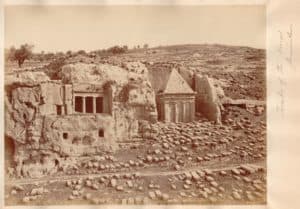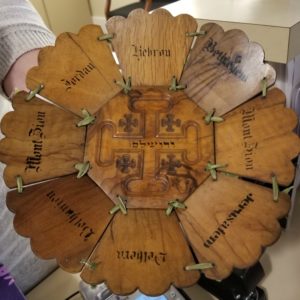Soon after his arrival in the Middle East, Lew Wallace helped Jews fleeing to Syria from the pogroms of Russia and Romania. Officials of the Ottoman Empire did not welcome these poor refugees. However, Lew used his friendship with the Sultan to obtain a reprieve for the refugees. He also assisted in getting relief supplies for this starving population. Sultan Abdul Hamid II did not, however, permit the Jews to settle in Palestine.
Lew assisted Jewish people in other ways during his time in the Middle East. He was presented with a hand-made scroll thanking him for his good deeds and proclaiming him “the champion of the oppressed and persecuted.”
Pilgrimage to Israel

In November 1882, Lew and Susan Wallace made a pilgrimage to Israel. Susan’s sister Joanna Lane, recently widowed, accompanied them on their journey. Cook’s Tours arranged and conducted the tour. Lew and Susan traveled with Tevfik Bey, governor of Jerusalem, and Selah Merrill, U. S. Consul to Jerusalem.
The Ottoman Empire controlled Israel at that time, but Lew’s connection with the Sultan granted him special access. The group sailed by steamship to Jaffa (now Tel Aviv). From Jaffa they went by caravan to the city of Jerusalem, where they stayed at the Hotel Mediterranean.
By Horseback through Israel
On November 14, the group departed on horseback for a five-day tour. They left Jerusalem by way of the Jaffa Gate. Along the way, they saw the Well of the Magi, David’s Tower, and Rachel’s Tomb. The group lunched near the pools of Solomon. Then they traveled on to Hebron, where they spent the night. They also visited the Cave of Machpelah, which tradition names the burial spot of Abraham, Isaac, and Jacob.
Bethlehem
Bethlehem was little among the thousands of Judah. About six miles south of Jerusalem, it lies east of the main road to Hebron, covering the upper slope and top of a narrow ridge of limestone. The town is built in square, solid houses, and close under it is the plain, smiling with vineyards and barley fields, where Ruth came to glean in the early days of Israel. The waters go softly in the pretty brook which runs through it yet—a scene fair to the eye, pleasant to memory. There is the Field of the Shepherds where angelic voices, heard but once on earth, sang peace and good will, and there, by the gate, is the well for which the captive David longed. — Susan Wallace, The Repose in Egypt

Returning by way of Bethlehem, they dined with the Greek patriarch of the Church of the Nativity. The patriarch presented the General with three mother-of-pearl medallions from the altar of that church. From Bethlehem they journeyed across the Judean Desert to Mar Saba. The Mar Saba monastery perched virtually on the perpendicular sides of a mountain.
Only the men could visit the monastery. Susan and Joanna waited in the tents below. From Mar Saba they continued on to the Dead Sea. Joanna Lane commented that the waters of that sea tasted “as bitter as death.” They waded in the River Jordan and spent the night at Jericho, tenting near the Fountain of Elisha.
Jerusalem
One Sunday, while returning to Jerusalem from the Mount of Olives, by way of the King’s Dale, we followed the dry bed of the Kedron to where the waters of Siloa go softly, now, as in the age of miracles, an intermittent fountain. A Syrian woman was drawing water in an earthen jar. — Susan Wallace, The Repose in Egypt
On their return to Jerusalem they entered the city by the Damascus Gate. They saw the Valley of Kedron, the Well of Enrogel, the Mount of Olives, Gethsemane, Bethany, Antonia Fortress, and the Dome of the Rock.
As Wallace toured the Holy Land, checking locations against his descriptions in Ben-Hur, he felt his book was accurate. He said: “I found the descriptive details true to the existing objects and scenes, and I find no reason for making a single change in the text of the book.”